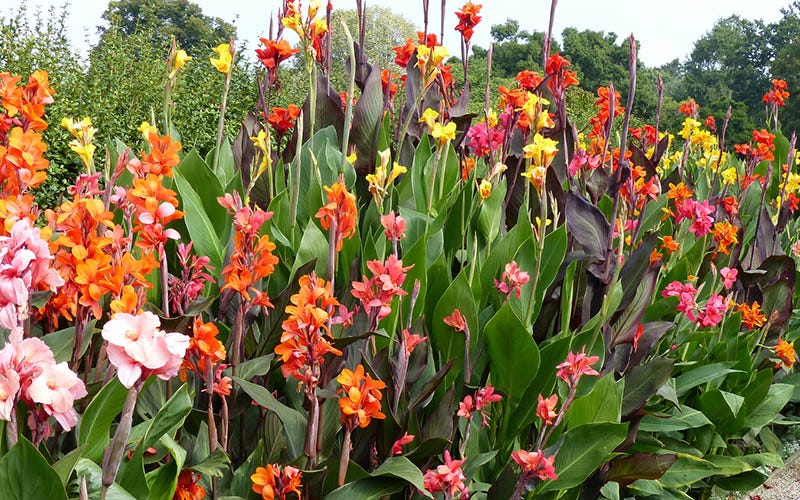By Katie Elzer-Peters, gardening expert and writer
Nothing says “island vacation” like a huge, healthy stand of Canna Lilies. While some varieties originate in the warmer climes, these giant herbaceous plants are also right at home in northern gardens. Everyone, from zones 2 to 10, can grow Cannas.
Canna Lilies: A Bit of Botany For Gardeners
While often referred to as bulbs, Cannas actually sprout from rhizomes, which are underground stems. Understanding the way the plants grow will help when it comes time to dig and divide Cannas. Cannas growing in suitable, in-ground conditions will spread via this rhizome, sometimes aggressively. Plants also produce seed, but it is much more common to acquire them as divisions of rhizomes.
For all intents and purposes, you can treat Cannas as bulbs while growing them, but dividing rhizomes is different. You can’t really cut a true bulb in half, but you can cut a Canna rhizome in half, as long as each resulting piece has an 'eye' (aka, a sprout - just like a potato).
Cannas can stay in the ground during the winter in zones 7-10. In zones 6 through 2, you have to 'lift 'and store them if you want to keep plants from year to year.

Canna Lilies: Tropical Look for Temperate Gardens
Cannas lend a specific look and feel to a landscape — instant tropical oasis. In large botanical gardens like Chanticleer and The Biltmore Estate, Cannas have been seamlessly integrated into mixed borders or gardens, giving a tropical flair to a traditional garden.
To create a tropical oasis with Cannas, combine with other sun-loving perennials, annuals, and shrubs that evoke island breezes. (The bulbs and perennials listed below may have different hardiness zones - click to learn more about the varieties to see if they are suitable for your growing conditions.)
Perennial or Cold-Hardy Canna Companions
Annual or Tropical Canna Companions
- Bird of Paradise
- Elephant Ear
- Agapanthus
- Gladiolus
- Caladium
- Dahlias

Cannas, with their large, often multi-colored leaves, are useful in the landscape, even if you don’t want to create a Caribbean-themed garden. Layer them into a border or flower bed, planting the rhizomes in the center or back of the bed and surrounding them with other plants of varying forms and textures.
Instead of planting cannas as a single big block, alternate them in the landscape bed along with a few other strategically placed larger plants. Dahlias and Maximilian's Sunflower are both tall plants with finer textured leaves for some variety among the “giants.”
Daylilies, ornamental grasses, Crocosmia, Helenium, Scabiosa, and verbena are all excellent medium and short companions for a more traditional look in the garden.
How to Grow Cannas in Containers
If you’d like a taste of the tropics, but you don't want to grow Cannas in-ground, if your soil is too dry and fast-draining, or if you live in a cold-winter zone, containers are the way to go.
Big beautiful Canna container gardens involve huge pots. Select a container that’s 18 to 24 inches in diameter (at a minimum) in which to grow cannas. Any smaller and you’ll be watering multiple times per day and the container will likely tip over in a stiff wind.
If you’ve ever had any training in floral design, you’ll have learned about the rule of thirds. The container should be 1/3 of the height of the arrangement for the composition to look proportional.
- Fill a large pot with lightweight soil, and plant rhizomes 2-3 inches below the soil level.
- Leave at least 2 inches between the top of the soil and the edge of the container so that the water doesn’t run over the side of the container.
- Abide by the same advice for landscape plantings, and layer with some plants of varying heights—suggestions are listed above. Anything that softens the bottom of the Canna plant will do!
As plants grow you’ll find yourself needing to water up to once per day. You can also set the container in a tray filled with water to avoid an afternoon slump. If you're unable to meet your Canna Lilies' watering needs, you can expect smaller plants with smaller leaves.
Overwintering Cannas Where It’s Cold
In zones 6-2 you’ll need to dig up canna rhizomes and bring them inside for the winter.
Alternatively, if you have grown them in pots, you can bring the pots into a garage or basement. Keep plants in pots dry until you move them outside for the summer.
Plants can be replanted outside or moved outside when nighttime temperatures are consistently above 50 degrees.
About the Author: Katie is a writer, runner, and reader, living in southern coastal North Carolina. Her favorite garden is her "wildflower patch" where something new is always blooming (or taking over).



